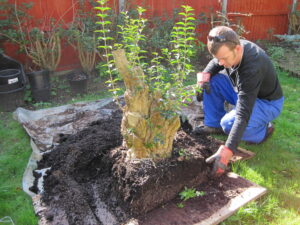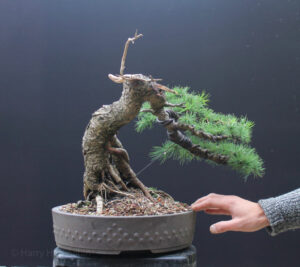The subject of this Progression Series started its life as a bonsai in fairly unfortunate circumstances. I had initially discovered it growing alongside a dirt track during the Winter of 2001-2002. I decided against collecting it immediately but chopped the trunk back hard to encourage more low-growing shoots, with a view to collecting it during the Spring of 2003. Sometimes it is simpler to work on a tree while it is still in the ground rather than taking it home immediately and having to find room for it in the garden!
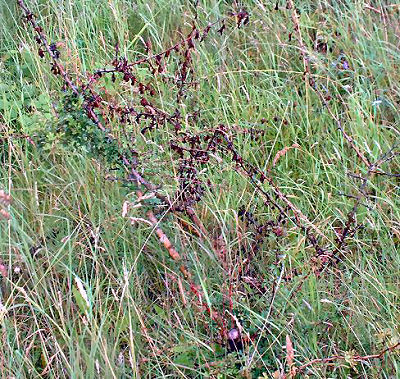
August 2002: You can normally guarantee that a tree that has grown undisturbed in the ground for 20-30 years will continue to do so in the year after you start working on it. Unfortunately while walking around my collecting-grounds the following August, I discovered that the tree had been run over by a car driving along the dirt track and had been completely uprooted. As can be seen in the image above, the leaves had already collapsed and browned off, a sure sign that a tree is drying out and very likely to die unless immediate action is taken.
What possessed me to even bother picking up what was left of the tree I don’t know, it was a mess!

As can be seen in the images above, there were very very few roots left! The tree had been lying on it’s side with what remained of its root system exposed to the air for at least 2-3 days. Fortunately it had come to rest covered in wet grass and this had stopped the roots from drying excessively. August in my part of the UK can have periods of very warm, wet and humid weather and this had also helped stop the wood from drying out too much; a few weeks earlier and the tree would have rapidly dried out and died in the hot July sun.
In the images above you can see that I removed all damaged roots and limbs and then carefully tidied up all of the wounds with a sharp knife (torn and ripped wood is more difficult for the tree to seal requiring greater resources and further weakening the tree). All of the wounds were treated with a thin smear of petroleum jelly only. The tree was planted up into pure sphagnum moss and the tree and its pot were left soaking in a shallow tray of water.
The purpose of placing the tree and its pot into water was to ensure that the remaining wood could not dry out and to almost ‘force’ water to enter the tree by thoroughly soaking the base. Co-incidentally, I didn’t bother to use any magic potions of the Superthrive variety.
October 2002: By early-September, new buds and embryonic leaves had started to appear. These will have been produced by the tree purely from stored resources within the trunk and branches. By mid-October those new buds had produced 5 or 6 strong shoots that indicated that the tree would almost certainly have produced new roots from what was left of its old root system. By this time the tree had been placed on a bench; while the water was useful during the initial recovery process, once it became evident that the tree was growing new roots, it was important that they were not left submerged in water for too long.
While I was pleased that the tree was very likely to survive, what remained of the tree (see images above) wasn’t actually that good for bonsai! While the trunk had some decent mature bark and some nice movement, it was too tall (for its girth) and lacked any usable low branches to chop the trunk to.
I kept the tree protected from the worst of the cold throughout the following Winter by placing the pot on a heated growing bed and then in the late Spring of 2003, when the tree had leafed out again and it was obviously strong enough, I planted it out into my growing field. As there was nothing that particularly excited me about the state of the tree and I had also noticed that the new roots had grown from only one-side of the trunk base, I (fortuitously) decided to plant the trunk at an angle to the ground so that the trunk looked as though it had fallen over. The tree was placed on top of a buried tile in the ground to keep the roots growing laterally and to stop any deep-growing tap-roots and it was then left to grow for three years.

March 2006: 3 years later and the Hawthorn had fully recovered its vigour, having produced plenty of very strong vertical shoots. During the previous years the tree had simply been fed with an annual slow release fertiliser and pruned back each Winter, otherwise it was left to its own devices.
I decided that the trunk and its new branches (or ‘trunks’) had much more interest, dug the tree up from the ground and bought it home to style into a bonsai. As can be seen in the image above, taken after bare-rooting (to remove all ground soil) and heavy root pruning, a new and very strong root system with plenty of shallow and fibrous roots had developed over the previous 3 years.

The tree was planted up into an over-sized mica training pot at the same angle that it had been growing in the ground. The tree could now be styled for the first time.
A couple of hours later and the tree has been styled ready for the forthcoming growing season. I chose 5 shoots of varying heights and thicknesses to create an image of 5 trunks growing from the fallen stump of an old tree. All other live growth was then removed as this would in turn prompt plenty of new shoots during the growing season that could be developed into the trunks’ branches. These new ‘trunks’ were then wired to ensure they grew upright and so they could be precisely positioned.
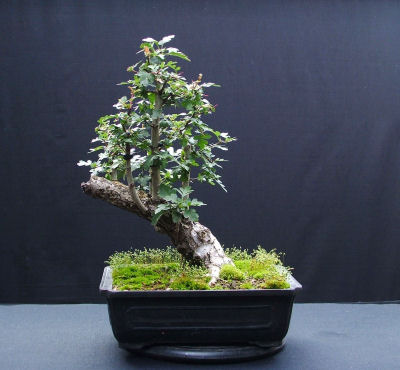
August 2007: The bonsai responded as predicted to its initial styling, producing excessive numbers of new branches from which I could build a new branch structure. The bonsai was repeatedly pruned throughout the Summer of 2007 to encourage plenty of fine branches and ramification.
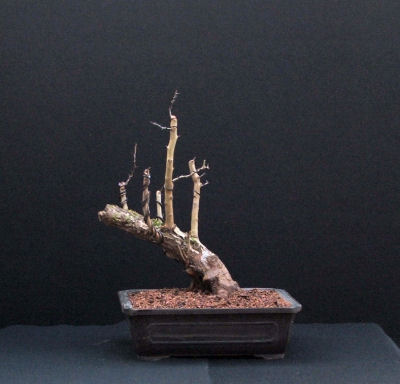
November 2007: 18 months after being lifted from my growing field and over 5 years since collection, the tree had been completely transformed. In the image above it had been pruned back and restyled after leaf-fall to refine its new branch structure. Note that the branches had very purposely been positioned so that they grow upwards as you would expect branches of a deciduous tree to grow; not with the cartoon-like downward raked branches of a Pine, something that can be seen too commonly in bonsai.
It was ready for a proper bonsai pot, a shallow ‘landscape’ pot was commissioned from Vic Harris of Erin Pottery.
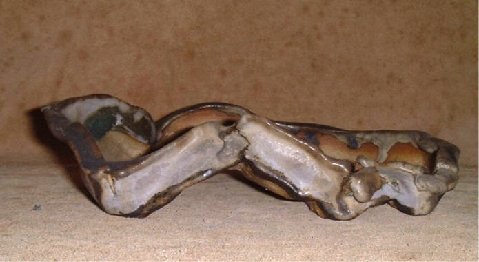
Vic designed a distressed and ‘damaged’ pot to compliment the design of the bonsai itself
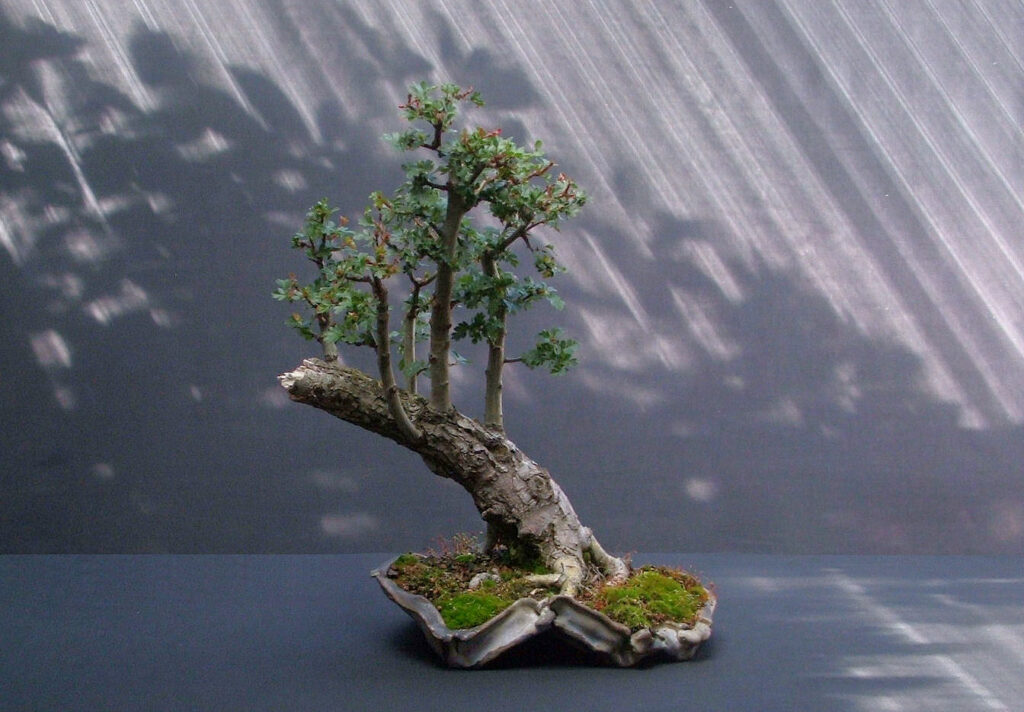 Fallen trunk Hawthorn bonsai
Fallen trunk Hawthorn bonsai
March 2008 and the bonsai is finally planted up into it’s new pot to complete the image. Current height of bonsai: 13.5″/33cm
While I had some serious doubts that the tree was worth saving 6 years ago, with the help of a little luck, I am very pleased at how it turned out as a bonsai!

